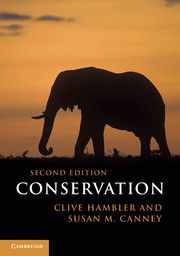Book contents
- Frontmatter
- Contents
- Preface to the Second Edition
- 1 Introduction to conservation
- 2 Threats to biodiversity
- 3 Evaluation of priorities for species and habitats
- 4 Monitoring and Environmental Impact Assessment
- 5 Management of natural and fragmented habitats
- 6 Management of species
- 7 Sustainable use, semi-natural cultural landscapes and the matrix
- 8 Restoration and offsetting
- 9 Environmental policy
- References
- Index to species names
- Index
- Plate section
Preface to the Second Edition
Published online by Cambridge University Press: 05 February 2013
- Frontmatter
- Contents
- Preface to the Second Edition
- 1 Introduction to conservation
- 2 Threats to biodiversity
- 3 Evaluation of priorities for species and habitats
- 4 Monitoring and Environmental Impact Assessment
- 5 Management of natural and fragmented habitats
- 6 Management of species
- 7 Sustainable use, semi-natural cultural landscapes and the matrix
- 8 Restoration and offsetting
- 9 Environmental policy
- References
- Index to species names
- Index
- Plate section
Summary
Preface to the Second Edition
Conservation is at the core of environmental science and action. It is increasingly influencing the policy of governments and the behaviour of individual people. Maintenance of the diversity of species and habitats and the sustainable use of resources are essential to protect the options, welfare and prosperity of future generations. Many would argue that it is also a strong moral imperative that humanity does not needlessly destroy other inhabitants of this planet.
This book aims to give an overview of conservation and to demonstrate the many interdependent specialisms it requires. We emphasise generalities, which are illustrated by examples from around the world. The book is intended as an aid for coursework, fieldwork and management – and to generate debate. A huge amount is being written about conservation, and this book should help to guide readers towards the most influential specialist sources.
Environmental sciences are advancing rapidly, against a cultural and policy background that is changing even faster. This second edition contains substantive updating in all chapters, and colour plates. There have been advances in knowledge about wildlife, including its richness and distribution, while the discussion of ecosystem services, sustainability, resilience and mitigation has risen in prominence, helping to emphasise human links to nature. Sections on marine biology, sustainability, the landscape matrix, restoration and monitoring are heavily revised, as is the chapter on policy, environmental economics and behaviour. We now include referencing to sources, particularly where topics are controversial or the material might be hard to find – and we urge readers to review the supporting evidence for themselves. We have included detailed research on European semi-natural habitats as this has increasing relevance to cultural landscapes and sustainability worldwide.
- Type
- Chapter
- Information
- Conservation , pp. ix - xPublisher: Cambridge University PressPrint publication year: 2013



